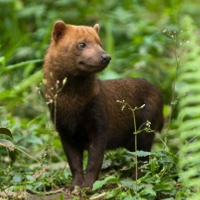 |
Bush dog |
|
He is a wild animal |
Origin |
Brazil | |
Translation |
Francis Vandersteen |
| The possession of this animal is not authorized Royal Decree establishing the list of mammals not kept for production purposes that may be kept (M.B. 24.08.2009) |
| The bush dog, or wood dog, is a small South American canid, the world's only representative of the Speothos genus. At 30 cm high and 60 cm long, it is also the smallest of Brazil's six canid species. It's so shy and mysterious that naturalists say you're more likely to spot a jaguar than this strange, little-known wild dog. In Brazil, it's called cachorro-vinagre (vinegar dog) because of its color. But few of us have had the good fortune to come across him along the way. Although they live in small packs, they are very discreet animals. It lives mainly in forests and swampy areas, and can be found in the Amazonian and tropical parts of South America as far south as Panama, but its most extensive range is in Brazil, covering almost the entire country with the exception of the semi-arid Nordeste region and the southern Pampas. Despite occupying such a vast territory, the species is little known. Although fossils of this species were found in 1842, and it was thought to be extinct since no one had ever seen it before, it was only at the end of the 19th century that it was observed for the first time. It is one of those rare animals whose fossils are discovered before the living species. In this respect alone, the wood dog is a very unusual animal, but its strangeness doesn't stop there. In fact, this little canine, which weighs no more than 6 or 7 kg as an adult, is totally adapted to semi-aquatic life. It has membranes between its fingers that act as flippers when it's in the water. This strange peculiarity makes it the only canid capable of diving to catch fish, and also enables it to swim long distances. In this respect, it could be likened to a bear or an otter, which it sometimes resembles. From a distance, it can also be confused with peccaries (wild pigs), and even cabiais (large rodents) known here as capirava. But that's as far as the resemblance goes, and beware of any of these species if you get too close, as they are on the menu of the wood dog, which, although smaller, hunts these species. On the menu are rodents, especially agoutis, and even very large ones such as paca and capivara, but also reptiles, amphibians and birds, as the wood dog is totally carnivorous. But it also has its predators, the jaguar, jacaré (caiman) and anaconda. Groups are made up of 8 to 10 individuals, generally adult couples and puppies, with the pack being extremely hierarchical and dominated by the oldest couple. This makes the anaconda the only South American canid to live in a group, on the same model as wolves. Like domestic dogs, individuals communicate by barking, which is silenced when intruders approach. It's not unusual to hear them from a distance, but it's almost impossible to see them. Their habits are diurnal, and from evening bush dogs hide in cavities in the ground or in old tree trunks. They have a reddish-brown coat, with tones varying from region to region, a short tail and small, round ears. The species, already quite rare, is threatened by deforestation and the draining of wetlands for agriculture. To date, there are no reliable data on the species' population, only that most groups are now isolated in the pockets of forest still standing, a situation that should eventually lead to inbreeding problems. |






 English (United Kingdom)
English (United Kingdom)